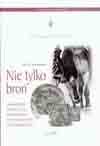Nie tylko broń. Drobne przedmioty codziennego użytku na wyposażeniu wczesnośredniowiecznego wojownika w świetle znalezisk grobowych z ziem polskich
Not only the weapons. Small objects of everyday use in the inventory of an early-Medieval warrior in the light of grave finds from Polish lands
Author(s): Tomasz KurasińskiSubject(s): Archaeology
Published by: Łódzkie Towarzystwo Naukowe
Summary/Abstract: Equipment of an early-Medieval warrior was not limited to arms, but included also other artifacts, being accessories used during military expeditions. Author discusses this issue basing on early-Medieval (end of 10th – 13th cent.) graves from Polish lands, including military artifacts and so-called every-day use objects. The following artifact categories were selected for the analysis: knives (with sheath ferrules), tinder-boxes, flints, whetstones, so called ring-pins, sickles, awls, needles, combs, razors, scissors, keys, fishing hooks and fastening hooks. They come from 197 burials, discovered at 70 burial grounds. The performed analysis suggests that the majority of the discussed objects could have been used by the warriors under war conditions. The utilitarian character of the accessories revealed fully during river-crossing, camping and prolonged sieges. Under these circumstances there has always been a need to ignite a camp-fire, prepare and consume a meal, repair the camping equipment, weapons, clothes and even perform hygienic and body-care activities, and on the march, to make a passage through forest thicket. The tools and accessories were most probably warrior’s property, so they were carried as personal equipment. Small objects and provisions were most likely carried in pouches, made of textiles or leather. Whetstones, tinder-boxes and ring-pins, and especially knives were usually placed in leather sheaths, attached to the belt or suspended on the neck. The author is careful in interpretation of a sickle as a distinction of a rider. On the included territory no grave has been found so far with a sickle appearing together with military artifacts considered as attributes of a rider or manifesting ones wealth (spurs, caparison, sword). Besides the grave from Końskie (No 85), where it was found along with a dagger, no other grave with weapons contained a sickle. The author emphasizes also the fact, that the analyzed artifact categories, besides technical-utilitarian functions, are linked also to symbolical-magic content.
Journal: Acta Archaeologica Lodziensia
- Issue Year: 2008
- Issue No: 54
- Page Range: 27-50
- Page Count: 24
- Language: Polish

